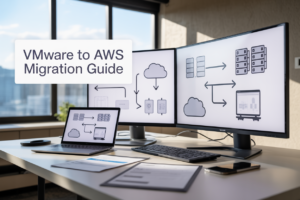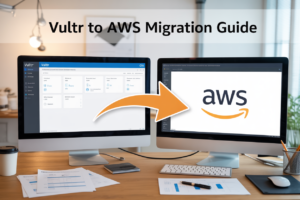Your AWS application is throwing errors, users can’t access your site, and the logs show cryptic messages about missing host headers. Sound familiar? This AWS debugging nightmare hits DevOps engineers, site reliability engineers, and cloud architects who manage complex AWS infrastructure daily.
When host header missing errors strike your AWS environment, they can take down entire applications while leaving you scratching your head. These issues often hide deep within your AWS load balancer troubleshooting workflow, making them particularly tricky to track down. The symptoms look straightforward, but the root cause usually lurks in unexpected places within your AWS infrastructure debugging process.
We’ll walk through recognizing the telltale signs of host header problems that masquerade as other issues. You’ll learn systematic AWS troubleshooting techniques that actually work, including how to dig into your AWS ALB configuration when standard fixes fail. Finally, we’ll cover implementing permanent solutions that prevent these AWS networking issues from returning to haunt your infrastructure.
Recognizing the Host Header Crisis Symptoms
Identifying intermittent 400 Bad Request errors
Random 400 Bad Request errors started hitting our production environment without warning. Users reported sporadic failures when accessing different parts of our application, but the errors weren’t consistent – the same requests would work fine minutes later. These intermittent failures made debugging particularly challenging since traditional monitoring tools showed mixed success rates rather than clear failure patterns.
Spotting load balancer health check failures
The AWS ALB health checks began failing unpredictably across different target instances. Dashboard metrics showed healthy targets suddenly appearing unhealthy, then recovering without any code deployments or infrastructure changes. These fluctuating health check statuses created a cascade of issues as the load balancer removed and re-added instances from rotation, causing additional user-facing disruptions during peak traffic periods.
Discovering SSL certificate validation issues
Certificate validation errors emerged seemingly out of nowhere, despite our SSL certificates being valid and properly configured. Users encountered security warnings and connection failures when accessing HTTPS endpoints. The SSL handshake process was breaking down intermittently, suggesting the problem wasn’t with the certificates themselves but rather how the AWS infrastructure was handling hostname verification during the TLS negotiation process.
Analyzing user authentication redirects breaking
OAuth redirects and authentication flows started failing randomly, leaving users stuck on login screens or redirected to error pages. The authentication provider couldn’t validate redirect URIs because the host header information was missing or malformed during critical redirect steps. This broke our entire user onboarding process and caused authenticated sessions to unexpectedly terminate, forcing users to repeatedly attempt logins.
Understanding AWS Infrastructure Components Involved
Application Load Balancer configuration mysteries
AWS Application Load Balancers can strip or modify host headers during request processing, creating invisible routing problems. The ALB’s target group health checks, listener rules, and host-based routing configurations all interact with the original host header from incoming requests. When debugging missing host headers, check if your ALB listener rules are configured to preserve the original host header or if they’re inadvertently modifying it through redirect actions or fixed response rules.
CloudFront distribution host header forwarding
CloudFront distributions control which headers get forwarded to origin servers through cache behaviors and origin request policies. By default, CloudFront doesn’t forward the host header to custom origins, replacing it with the origin domain name instead. This behavior often breaks applications expecting specific host values for virtual host routing or SSL certificate validation. Configure your distribution’s cache behavior to whitelist the host header or use origin request policies that explicitly forward host headers to maintain proper request context.
EC2 instance web server virtual host setup
Web servers like Apache and Nginx rely heavily on host headers for virtual host routing and SSL certificate selection. When the host header goes missing or gets modified upstream, your EC2 web server might serve default sites, wrong SSL certificates, or throw configuration errors. Virtual host configurations that depend on specific host header values will fail silently, serving fallback content that looks correct but breaks application functionality. Check your server configuration files for host-based routing rules that might be causing unexpected behavior when headers don’t match expected patterns.
Initial Troubleshooting Steps That Led Nowhere
Checking basic DNS resolution and routing
The first instinct when facing AWS load balancer troubleshooting issues is verifying DNS resolution. Running nslookup and dig commands against the load balancer endpoint showed proper A record resolution to multiple IP addresses. Route 53 health checks appeared green across all regions, and traceroute revealed standard AWS network paths without packet loss or unusual latency spikes.
Verifying security group and NACL configurations
Security groups seemed straightforward – inbound rules allowed HTTP/HTTPS traffic from 0.0.0.0/0, while outbound rules permitted all traffic. Network ACLs at the subnet level showed default allow-all configurations. Port 80 and 443 connectivity tested successfully using telnet from external machines. The AWS infrastructure debugging approach here ruled out basic networking restrictions as the culprit behind the missing host header fix requirements.
Examining application logs for obvious errors
Application servers running behind the ALB showed normal startup sequences and healthy status endpoints. CloudWatch logs revealed standard request patterns without 4xx or 5xx error spikes. Application-level logging captured incoming requests with proper HTTP methods and paths, but something felt off about the request headers. The logs didn’t immediately reveal the host header missing pattern that would later become central to our AWS ALB configuration investigation.
Testing direct instance connectivity bypassing load balancer
Direct IP address connections to individual EC2 instances worked flawlessly. Curl commands against instance IPs returned expected responses with proper content. This bypass test confirmed the application layer functioned correctly, pointing toward AWS networking issues somewhere in the load balancer chain. The fact that direct connectivity succeeded while load balancer requests failed became a crucial clue in our AWS load balancer troubleshooting methodology.
Deep Diving into Load Balancer Configuration
Inspecting Target Group Health Check Settings
Target group health checks play a crucial role in AWS load balancer troubleshooting, especially when dealing with missing host header issues. The health check path configuration directly impacts how your ALB validates backend services. If your health check doesn’t specify the correct host header or path, it can cause intermittent failures that manifest as missing headers downstream. Check the health check protocol, port, and most importantly, the health check path settings. Many engineers overlook the advanced health check settings where you can specify custom host headers. When your application expects a specific host header but the health check sends a different one, you’ll see sporadic connection issues that appear as host header problems.
Analyzing Listener Rules and Host-Based Routing
AWS ALB listener rules govern how traffic gets routed based on host headers, making this a critical area for AWS load balancer troubleshooting. Each listener rule can have conditions based on host headers, paths, or HTTP methods. When debugging missing host header errors, examine each rule’s priority and conditions carefully. A misconfigured host-based routing rule can strip or modify headers before they reach your target. Look for wildcard matching patterns that might be too broad or too restrictive. Default actions often catch traffic that doesn’t match specific rules, potentially causing unexpected behavior. The order of rule evaluation matters – lower priority numbers execute first, so a catch-all rule early in the sequence might intercept traffic meant for specific host-based rules.
Reviewing SSL Certificate Domain Matching
SSL certificate domain matching becomes critical when AWS debugging involves HTTPS traffic and host headers. Your ALB’s SSL certificate must match the domain names your application expects in the host header. Certificate domain mismatches can cause the load balancer to reject requests or modify headers unexpectedly. Check both the primary domain and Subject Alternative Names (SAN) in your certificate. Wildcard certificates can solve multi-subdomain scenarios but require careful configuration. When certificate domains don’t align with expected host headers, browsers and applications may receive unexpected responses or connection errors. AWS Certificate Manager integration simplifies this process, but manual certificate uploads require extra attention to domain validation and renewal processes.
Examining X-Forwarded Headers and Preservation Settings
X-Forwarded headers contain vital information about the original request, and their preservation settings directly impact host header availability in your application. AWS ALB automatically adds X-Forwarded-For, X-Forwarded-Proto, and X-Forwarded-Port headers, but the original host information lives in X-Forwarded-Host. Your application code must check for these forwarded headers when the direct host header appears missing. Load balancer target group attributes control header preservation behavior. The preserve_host_header attribute specifically determines whether the original host header gets passed through unchanged. Connection draining settings can also affect header handling during deployments or scaling events. Review your application’s header parsing logic to ensure it checks both direct host headers and X-Forwarded alternatives for complete AWS networking issues resolution.
Uncovering the Root Cause Through Systematic Analysis
Capturing and analyzing HTTP request headers
Start by capturing raw HTTP traffic using AWS VPC Flow Logs and CloudWatch Insights to examine header patterns. Deploy tcpdump on EC2 instances or use AWS X-Ray tracing to intercept requests between your load balancer and backend services. Look specifically for missing or malformed Host headers in the request chain, comparing successful requests against failed ones to identify discrepancies in header propagation.
Tracing requests through multiple AWS service layers
Map your request flow from CloudFront through Application Load Balancer to target groups and EC2 instances. Use AWS CloudTrail and VPC Flow Logs to track each hop, documenting how headers transform at each layer. Enable detailed monitoring on your ALB and check target group health checks – often the Host header gets stripped or modified during health check processes, revealing configuration issues in your AWS load balancer troubleshooting efforts.
Identifying missing Host header in backend requests
Check your ALB listener rules and target group configurations for Host header preservation settings. Many AWS infrastructure debugging scenarios reveal that default ALB behavior doesn’t forward the original Host header to backend services. Examine your application code expectations – if your backend requires specific Host header values for routing or security purposes, configure ALB rules to preserve or inject the correct headers using custom routing rules.
Implementing the Fix and Preventing Future Issues
Configuring proper host header forwarding rules
Start by updating your AWS ALB configuration to preserve the original Host header through proper forwarding rules. Navigate to your load balancer’s target group settings and enable the “preserve_host_header” attribute using the AWS CLI: aws elbv2 modify-target-group-attributes --target-group-arn your-arn --attributes Key=preserve_host_header.enabled,Value=true. For Application Load Balancers, configure listener rules that explicitly forward the Host header to backend services, ensuring your applications receive the correct hostname information for proper request routing and SSL certificate validation.
Setting up comprehensive monitoring and alerting
Deploy CloudWatch custom metrics to track host header presence across your load balancer requests. Create a Lambda function that parses ALB access logs and generates alerts when missing host header patterns emerge. Set up CloudWatch alarms with thresholds that trigger SNS notifications when host header errors exceed 1% of total requests. Monitor key metrics like HTTP 400/502 errors that often correlate with host header issues, and establish dashboard widgets showing real-time host header forwarding status across your AWS infrastructure.
Creating runbooks for similar troubleshooting scenarios
Document the systematic debugging approach for AWS load balancer troubleshooting scenarios involving missing headers. Your runbook should include step-by-step ALB configuration verification, target group health check procedures, and security group rule validation. Include AWS CLI commands for quick diagnostics: checking listener rules, target group attributes, and load balancer configuration. Create decision trees that guide engineers through common host header error patterns, complete with expected outputs and escalation procedures for complex AWS networking issues.
Establishing host header validation in deployment pipelines
Integrate automated host header testing into your CI/CD pipeline using tools like curl or Postman collections that validate header forwarding behavior. Create staging environment tests that verify proper host header transmission before production deployments. Implement Terraform or CloudFormation validation rules that check ALB configurations for proper host header forwarding settings. Add pre-deployment health checks that test end-to-end request flows, ensuring your AWS infrastructure debugging practices catch host header misconfigurations before they impact production traffic.
The missing host header disaster taught us that AWS debugging often requires methodical detective work rather than quick fixes. What started as mysterious symptoms led us through a maze of load balancers, target groups, and configuration settings that all seemed fine on the surface. The real breakthrough came when we stopped looking for obvious problems and started examining the subtle relationships between different AWS components.
Moving forward, always document your load balancer configurations and set up proper monitoring for host header validation. Create a systematic troubleshooting checklist that covers these edge cases, because the next time something breaks, you’ll want a clear path through the chaos. Remember that the most frustrating bugs often hide in the simplest places – sometimes the solution is just one checkbox away from being discovered.




















